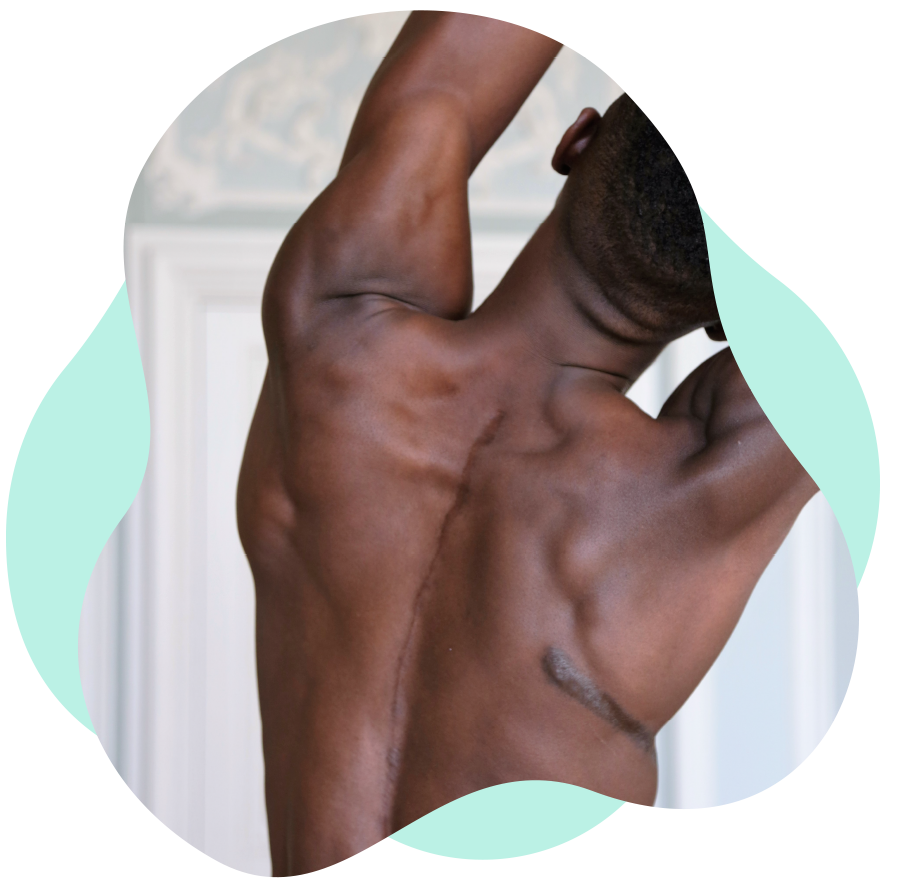Scoliosis and posture
Posture is more important than many people realise. Sitting or standing in the right position helps to make sure our bodies function properly.
When standing or sitting, poor posture uses high amounts of energy, which means our bodies need to rest for longer to recover. Some people with scoliosis might find good posture difficult, leaning forwards and to the side, sometimes at severe angles. Some will compensate for these difficulties and try to avoid standing or sitting in this way, they may, therefore, slightly bend their knees and tilt the pelvis backwards, causing strains on the body.
What is the ideal posture?
The ideal posture when standing is to have weight evenly spread, bearing an even amount of pressure on all the joints in the body. Joints are the places in the body where two bones meet. The neck joint should be straight with no tilt, the hips level, and the pelvis neither tilting forward or backwards. The knees should be either straight or one knee straight, the other slightly bent. It can help to check your posture regularly in the mirror, or get others to check it for you. Imagine yourself as a puppet with a string attached to the top of your head pulling you straight.
Poor posture can put a strain on the body causing pain and muscle tightness or weakness and can even change the way you move, meaning you aren’t able to move as much or in a variety of ways.
When you have scoliosis it may be difficult to follow these ideal posture positions but it is advisable to try to follow this guidance.
Sitting posture
A person’s sitting posture is as important as their standing posture. Ideally, we should all try to sit back in a chair with our weight evenly on the buttocks and thighs with the back straight. Try not to sit forward on the edge of your seat and keep the pelvis from tilting either forward or backwards. The best height for the chair is between 18 and 22 inches depending on how tall you are.
Good advice is to sit with your knees slightly lower than your hips. Keep feet flat on the floor and shoulder width apart. Try not to sit for too long at any one time. It is best to move every 30 minutes.
Getting a chair that suits your needs is useful. It may be that you can arrange a lumbar (lower back) support with cushions or memory foam. A balans (kneeling) chair can help to make you more aware of slouching, but can be painful on your knees. It is best to avoid low soft sofas, chairs without arms, chairs that are too low or too high, bucket chairs, deep chairs as these will not support your posture and can be difficult to get in and out of.
Beds and sleeping
Getting enough sleep is very good for your health and choosing the right bed is very important, if you are comfortable in your bed you are more likely to sleep well.
A good height for a bed is 18- 22 inches. This should make it easier to lie down and get up. Make sure you try before you buy as even if a bed is recommended, or is marketed as being good for back pain, it still may not be right for you.
The mattress should not be too hard nor too soft as it needs to support your weight without sagging or giving way at the hips and shoulders. Duvets are easier to use than sheets and blankets, and fitted sheets are recommended as this will be easier to use when getting in and out of bed. The base of your bed should be 30cm thick and should not have wooden slats, pillows should support your neck.
The best way to get into bed is to use something called the log rolling technique:
1. Sit on the side of the bed
2. Lie down onto your side, towards the pillow, before lifting your legs onto the bed
3. Turn onto back with legs together
*Reverse the steps to get out of bed.
Avoid:
- Sleeping flat on back with legs straight because this puts strain on the lumbar (lower) spine
- Too many pillows
- Sleeping on your front
Try:
- Sleeping on your back, with your knees bent and a roll support
- On your side with your leg bent forward
- On your side with a pillow between your legs or under your knees for better support, in the foetal position.
Keeping the pelvis in a neutral position
The pelvis is the large frame at the bottom of the spine which is attached to the legs. Keeping the pelvis neutral means it is not tilting forward nor backwards. A helpful trick to do this is to imagine the pelvis is a bucket of water. If the pelvis tilts forward the water would spill out of the front of the bucket and if the pelvis tilts backwards water would spill out of the back. Only when the pelvis is neutral will the bucket be level and no water spilt. Many adults with scoliosis will not be able to achieve this posture but it is advisable to aim for this ideal posture.
If you need help or advice please call our Helpline on 020 8964 1166 or email info@ssr.org.uk.




